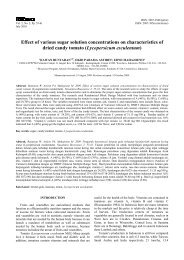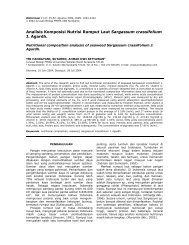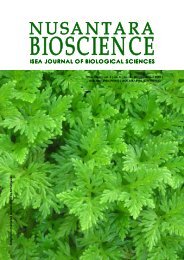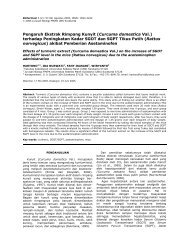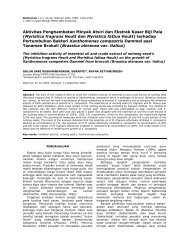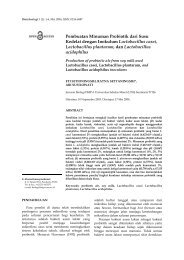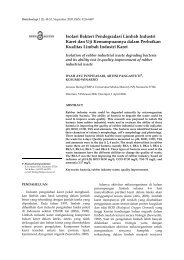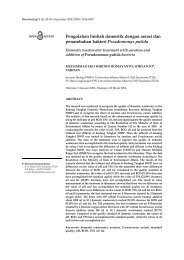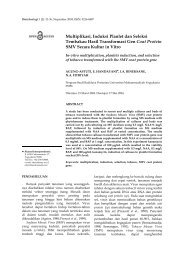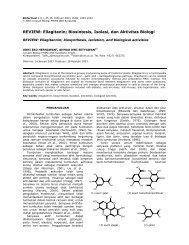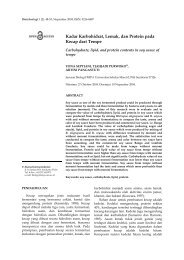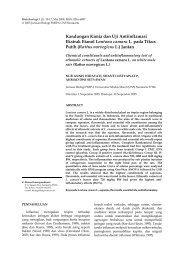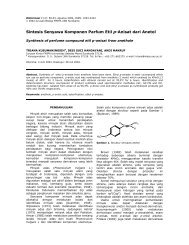Inventorying the tree fern Genus Cibotium of Sumatra: Ecology ...
Inventorying the tree fern Genus Cibotium of Sumatra: Ecology ...
Inventorying the tree fern Genus Cibotium of Sumatra: Ecology ...
You also want an ePaper? Increase the reach of your titles
YUMPU automatically turns print PDFs into web optimized ePapers that Google loves.
| Proc Soc Indon Biodiv Intl Conf | vol. 1 | pp. 118-125 | July 2012 | ISSN 2252-617X |<br />
<strong>Inventorying</strong> <strong>the</strong> <strong>tree</strong> <strong>fern</strong> <strong>Genus</strong> <strong>Cibotium</strong> <strong>of</strong> <strong>Sumatra</strong>: <strong>Ecology</strong>,<br />
population size and distribution in North <strong>Sumatra</strong><br />
TITIEN NGATINEM PRAPTOSUWIRYO ♥ , DIDIT OKTA PRIBADI, DWI MURTI PUSPITANINGTYAS, SRI HARTINI<br />
Center for Plant Conservation-Bogor Botanical Gardens, Indonesian Institute <strong>of</strong> Sciences. Jl. Ir. H.Juanda No. 13, P.O. Box 309 Bogor 16003, Indonesia.<br />
Tel. +62-251-8322187. Fax. +62-251- 8322187. ♥ e-mail: tienp<strong>fern</strong>s@yahoo.com<br />
Manuscript received: 26 June 2011. Revision accepted: 18 August 2011.<br />
Praptosuwiryo TNg, Pribadi DO, Puspitaningtyas DM, Hartini S.<br />
2012. <strong>Inventorying</strong> <strong>the</strong> <strong>tree</strong> <strong>fern</strong> <strong>Genus</strong> <strong>Cibotium</strong> <strong>of</strong> <strong>Sumatra</strong>:<br />
<strong>Ecology</strong>, population size and distribution in North <strong>Sumatra</strong>. Proc<br />
Soc Indon Biodiv Intl Conf 1: 118-125. <strong>Cibotium</strong> is one <strong>tree</strong> <strong>fern</strong><br />
belongs to <strong>the</strong> family Cibotiaceae which is easily differentiated<br />
from <strong>the</strong> o<strong>the</strong>r genus by <strong>the</strong> long slender golden yellowishbrown<br />
smooth hairs covered its rhizome and basal stipe with<br />
marginal sori at <strong>the</strong> ends <strong>of</strong> veins protected by two indusia<br />
forming a small cup round <strong>the</strong> receptacle <strong>of</strong> <strong>the</strong> sorus. It has<br />
been recognized as material for both traditional and modern<br />
medicines in China, Europe, Japan and Sou<strong>the</strong>ast Asia.<br />
Population <strong>of</strong> <strong>Cibotium</strong> species in several countries have<br />
decreased rapidly because <strong>of</strong> over exploitation and <strong>the</strong>re is no<br />
artificial cultivation until now. The aims <strong>of</strong> this study were: (i)<br />
To re-inventory <strong>the</strong> species <strong>of</strong> Cibotiun in North <strong>Sumatra</strong>, (ii) to<br />
record <strong>the</strong> ecology and distribution <strong>of</strong> each species, and (iii) to<br />
assess <strong>the</strong> population size <strong>of</strong> each species. Field study was<br />
carried out by using random search with belt transect. Two<br />
species were recorded, namely C. arachnoideum dan C.<br />
barometz. The geographical distribution <strong>of</strong> <strong>the</strong> two species in<br />
North <strong>Sumatra</strong> are presented. <strong>Cibotium</strong> is commonly growing<br />
terrestrially on opened or ra<strong>the</strong>r opened areas in secondary<br />
forets and primary forest at hills or lower mountains with a<br />
relatively high humidity at 30-90º slopes. C. arachnoideum has<br />
a strict distribution and only found at 1740-1770 m a.s.l. in<br />
primary forest, whereas C. barometz has a broad distribution in<br />
secondary forest at elevation range from 650-1200 m.<br />
<strong>Cibotium</strong>, ecology, distribution, <strong>tree</strong> <strong>fern</strong>, <strong>Sumatra</strong><br />
It is now widely recognized that current extinction rates<br />
<strong>of</strong> plant and animal species are between hundred and a<br />
thousand times higher than back rates throughout life’s<br />
history <strong>of</strong> Earth (May 2002). Therefore <strong>the</strong> world’s<br />
biodiversity should be inventoried and monitored.<br />
As defined by Stork and Samways (1995) biodiversity<br />
The original manuscript has been published as:<br />
Praptosuwiryo TNg, Pribadi DO, Puspitaningtyas DM, Hartini S. 2011.<br />
<strong>Inventorying</strong> <strong>the</strong> <strong>tree</strong> <strong>fern</strong> <strong>Genus</strong> <strong>Cibotium</strong> <strong>of</strong> <strong>Sumatra</strong>: <strong>Ecology</strong>,<br />
population size and distribution in North <strong>Sumatra</strong>. Biodiversitas 12:<br />
204-211<br />
Reprinted with permission<br />
inventorying is <strong>the</strong> surveying, sorting, cataloging,<br />
quantifying and mapping <strong>of</strong> entities such as genes,<br />
individuals, populations, species, habitats, biotypes,<br />
ecosystem and landscapes or <strong>the</strong>ir components, and <strong>the</strong><br />
syn<strong>the</strong>sis <strong>of</strong> <strong>the</strong> resulting information for <strong>the</strong> analysis <strong>of</strong><br />
pattern and processes. Inventory refers to a listing <strong>of</strong> all <strong>the</strong><br />
species <strong>of</strong> plants, animals, fungi, protest and microbes in a<br />
defined area. Survey refers to methodical exploration <strong>of</strong> an<br />
area in order to discover <strong>the</strong> species that live <strong>the</strong>re<br />
(Wheeler 1995). Inventories for rare plants may be<br />
designed to: (i) Locate populations <strong>of</strong> species; ( ii)<br />
Determine total number <strong>of</strong> individuals <strong>of</strong> species; ( iii)<br />
Locate all population <strong>of</strong> rare species within a specific area<br />
(<strong>of</strong>ten a project area); (iv) Locate all rare species occurring<br />
within a specific habitat type; ( v) Asses and describe <strong>the</strong><br />
habitat <strong>of</strong> rare species (associated species, soils, aspect,<br />
elevation); ( vi) Asses existing and potential threats to a<br />
population (Elzinga et al. 2005)<br />
There are three levels <strong>of</strong> monitoring for plant population:<br />
distribution, population size and demographic monitoring.<br />
These can be applied to species according to <strong>the</strong>irs<br />
protection and management objectives (Menges and<br />
Gordon 1996). Hutching (1991) described that <strong>the</strong> status<br />
and trends <strong>of</strong> plant population may be studied on four<br />
levels: population distribution, quantitative monitoring <strong>of</strong><br />
population size and (or) condition, monitoring <strong>of</strong><br />
population structure, and demographic study <strong>the</strong><br />
population. Basic information about <strong>the</strong> distribution and<br />
regional dynamics <strong>of</strong> different species is essential for<br />
practical conservation management <strong>of</strong> rare species, i.e.<br />
species with low relative abundance or distribution at<br />
continental, and particularly at regional and local levels.<br />
<strong>Cibotium</strong> Kaulfuss is a genus <strong>of</strong> about 12 species <strong>of</strong><br />
tropical <strong>tree</strong> <strong>fern</strong> (Holttum 1963; Hassler and Swale 2002)<br />
which is subject to much confusion and revision. Therefore<br />
it is treated in different family, such as in subfamily<br />
Cibotioideae <strong>of</strong> Cya<strong>the</strong>aceae (Holttum 1963), Cibotiaceae<br />
(Hassler and Swale 2002; Smith 2006). This genus is<br />
distributed in Central America and Mexico, Hawaii, Assam<br />
to sou<strong>the</strong>rn China, southwards to Western Malesia and<br />
Philippines (Holttum 1963).<br />
<strong>Cibotium</strong> comprises large <strong>fern</strong>s with usually prostrate or<br />
erect trunk-like rhizome and large bipinnate fronds. The<br />
apex <strong>of</strong> rhizome is protected by a thick cover <strong>of</strong> long<br />
slender golden yellow-brown hairs. These hairs are also<br />
long at <strong>the</strong> base <strong>of</strong> <strong>the</strong> stipe and <strong>of</strong>ten matted in appearance.
PRAPTOSUWIRYO et al. – <strong>Inventorying</strong> <strong>of</strong> <strong>the</strong> <strong>tree</strong> <strong>fern</strong> <strong>Genus</strong> <strong>Cibotium</strong> 119<br />
Sori are marginal, at <strong>the</strong> ends <strong>of</strong> veins, protected by two<br />
indusia which are alike in texture and diffrent from <strong>the</strong><br />
green lamina <strong>of</strong> lobes on which <strong>the</strong>y are borne, <strong>the</strong> outer<br />
indusium deflexed so that <strong>the</strong> sorus appears to be on <strong>the</strong><br />
side <strong>of</strong> <strong>the</strong> lobe, <strong>the</strong> inner indusium at maturity bending<br />
back towards <strong>the</strong> costule and elongating, usually becoming<br />
oblong, <strong>the</strong> two indusia joined toge<strong>the</strong>r for a short distance<br />
at <strong>the</strong> base, thus forming a small cup round <strong>the</strong> receptacle<br />
<strong>of</strong> <strong>the</strong> sorus (Holttum 1963; Large and Braggins 2004).<br />
One species <strong>of</strong> <strong>Cibotium</strong>, namely C. barometz, has been<br />
recognized as material for <strong>the</strong> traditional medicine and<br />
modern medicines in China, Japan and France (Zamora and<br />
Co 1986, Praptosuwiryo 2003). In China <strong>the</strong> species has<br />
important value for medicinal purpose which is known in<br />
medicinal trade as ‘gou ji’ (Jia and Zh ang 2001, Smith<br />
2009). The gold yellowish-brown hairs on its rhizome and<br />
stipes have been used in S.E. Asia and China as a styptic<br />
for a bleeding wounds (Zamora and Co 1986, Jia and<br />
Zhang 2001). The extract <strong>of</strong> <strong>the</strong> rhizome (‘gouji’) is also<br />
used by Chinese and Japanese as an antirheumatic, to<br />
stimulate <strong>the</strong> lever and kidney, to streng<strong>the</strong>n <strong>the</strong> spinal, to<br />
expel wind and damppnesss, and as a prostatic remedy<br />
(Zamora and Co 1986).<br />
Population <strong>of</strong> <strong>Cibotium</strong> species in several countries<br />
have decreased rapidly because <strong>of</strong> over exploitation and<br />
<strong>the</strong>re is no artificial cultivation until now. The species has<br />
been included in Appendix II <strong>of</strong> <strong>the</strong> Convention on<br />
International Trade in Endangered Species (CITES) since<br />
1976. In order to utilize it in sustainable use, NDF ( Non<br />
Detriments Finding) system has to be applied for<br />
determining <strong>the</strong> annual quotas. Biological aspect is one <strong>of</strong><br />
<strong>the</strong> important information that is needed to be known,<br />
including <strong>the</strong> ecology, population size and distribution. To<br />
obtain those data, inventories and monitoring <strong>of</strong> <strong>the</strong><br />
population need to be done.<br />
Based on <strong>the</strong> specimens examined housed at Herbarium<br />
Bogoriense (BO) <strong>the</strong>re was only one record <strong>of</strong> <strong>Cibotium</strong><br />
collected from North <strong>Sumatra</strong>. It was collected by H.<br />
Surbeck in on 30 May 1941 (No. Coll.: H. Surbeck 114)<br />
Sibuctan south, Lae Pondom (<strong>the</strong> correct name is Lao<br />
Pondom), 1100 m, edge <strong>of</strong> primary forest, and identified as<br />
C. barometz. The correct name <strong>of</strong> this record is C.<br />
arachnideum. This paper presents <strong>the</strong> recently data on<br />
ecology, population size and distribution <strong>of</strong> <strong>Cibotium</strong><br />
species in North <strong>Sumatra</strong>. For practical consideration, in<br />
this study, populations were defined as spatially distinct<br />
assemblages <strong>of</strong> plants at certain sites, without considering<br />
<strong>the</strong> genetic structure <strong>of</strong> <strong>the</strong> population. Following those<br />
defined by Landi and Angiolini (2008) populations were<br />
defined as discrete clusters <strong>of</strong> plants, separated from o<strong>the</strong>r<br />
cluster by at least 500 m.<br />
Most studies on <strong>the</strong> ecology, population and distribution<br />
<strong>of</strong> <strong>fern</strong>s were based on quantitative methodological<br />
approaches, such as Landi and Angiolini (2008; 2010),<br />
Banaticla and Buot (2005). However <strong>the</strong>se studies can also<br />
be approached by using qualitative methodology (Nitta<br />
2006; Boonkerd et al. 2008; Rusea et al. 2009). The aims <strong>of</strong><br />
<strong>the</strong> study were: (i) to re-inventory <strong>the</strong> species <strong>of</strong> Cibotiun<br />
in North <strong>Sumatra</strong>, (ii) to record <strong>the</strong> ecology and distribution<br />
<strong>of</strong> each species, and (iii) to assess <strong>the</strong> population size <strong>of</strong><br />
each species by using random search methodology using<br />
belt transect.<br />
MATERIALS AND METHODS<br />
Site studies<br />
Nine localities <strong>of</strong> <strong>Cibotium</strong> habitats included in six<br />
subdistrict <strong>of</strong> three district, Dairi District, Karo District and<br />
Deli Serdang District, were succesfully surveyed (Table 1).<br />
There is only one locality <strong>of</strong> <strong>Cibotium</strong> population found in<br />
Dairi District, namely Bukit Kota Buluh, Kota Buluh<br />
Village, Tanah Pinem subdistrict. Three localities are<br />
situated at Karo District, namely: (i) Bukit Butar, Butar<br />
Village, Tiga Binanga Subdistrict; (ii) Aik Batu Forest-Lau<br />
Pondom, Aik Hotang Village, Merek Subdistrict; (iii)<br />
Samperen Secondary Forest, Bukit Layang, Negeri Juhar<br />
Village, Juhar Village. Four localities are included in<br />
Sibolangit subdistrict, Deli Serdang district, namely: (i)<br />
Tikungan Amoi forest, Tahura Bukit Barisan, Bandar Baru<br />
Village; (ii) Betimus River, Wely forest, Sukamakmur<br />
Village, and (iii) Kataruman Forest, Takur-Takur Hill,<br />
Negeri Suah Village; (iv) Gunung Sibayak II, Treck Mata<br />
Air Petani, Bandar Baru Village. One locality situated in<br />
Kota Limbare Subdistrict <strong>of</strong> Deli Serdang District, namely<br />
Sungai Sae Binge Forest. Habitat characteristics <strong>of</strong> <strong>the</strong> nine<br />
localities are summarized in Table 2.<br />
Procedures<br />
Data on ecology and distribution was based on<br />
observation during field studies and also derived from<br />
herbaria sheet information or collection notes <strong>of</strong> specimens<br />
deposited at BO (Herbarium Bogoriense). Field studies<br />
were carried out in October-Desember 2009 in North <strong>Sumatra</strong><br />
province, Indonesia. Voucher specimens are deposited at<br />
BOHB (Herbarium <strong>of</strong> Bogor Botanic Gardens).<br />
Random search with belt transect is set up to estimate<br />
<strong>the</strong> population size or <strong>the</strong> abundance <strong>of</strong> adult plant <strong>of</strong> C.<br />
barometz in a certain area. Belt transect is very commonly<br />
used in studies on population biology <strong>of</strong> plants (see Lutes<br />
2002; Shenoy et al. 2011). In <strong>the</strong> study <strong>of</strong> C. barometz <strong>the</strong><br />
belt transect was set up in 20x125 m 2 or 20 x 250 m 2 with<br />
20 x 25 m 2 subplots (Figure 1). The position and number <strong>of</strong><br />
<strong>the</strong> transect were determined based on <strong>the</strong> spatial<br />
distribution pattern <strong>of</strong> C. barometz in each distribution<br />
areas. In general C. barometz reveals in <strong>the</strong> same direction<br />
<strong>of</strong> <strong>the</strong> contour <strong>of</strong> hills. Therefore, in this study <strong>the</strong> belt<br />
transect was established in <strong>the</strong> line <strong>of</strong> hills contour as this<br />
transect method is usually very suitable to be applied on <strong>the</strong><br />
field areas having hilly or mountainous contour. One<br />
transect was set up if <strong>the</strong> population <strong>of</strong> C. barometz in a<br />
certain areas was only found in certain slope. Minimally 3<br />
transects were set up in <strong>the</strong> situation in which C. barometz<br />
distributed from lower slopes to upper slope, viz. lower,<br />
middle and upper slopes. Population size data generated<br />
from transects were used to estimate <strong>the</strong> population size <strong>of</strong><br />
C. barometz in a certain areas in which its population<br />
performance were almost similar to <strong>the</strong> population<br />
performance in <strong>the</strong> transect. The transects commonly cover<br />
25-30% <strong>of</strong> <strong>the</strong> total distribution areas <strong>of</strong> C. barometz.
120<br />
Proc Soc Indon Biodiv Intl Conf 1: 118-125, July 2012<br />
Figure 1. Basic sampling unit <strong>of</strong> C. barometz survey, a long, 20 x<br />
250 m belt-transect, with subplots (20 x 25 m).<br />
The activities that have been carried out in this survey<br />
could be described as follows: (i) exploring <strong>the</strong> habitat <strong>of</strong><br />
C. barometz; (ii) morphological diversity observation; (iii)<br />
collecting population data; (iv) recording <strong>the</strong> associated<br />
plants with C. barometz and environmental condition<br />
around C. barometz vegetation (elevation, slope, air<br />
temperature and humidity, soil type in general, pH and<br />
humidity <strong>of</strong> soil, <strong>the</strong> thickness <strong>of</strong> litter and humus soil).<br />
In collecting population data only <strong>the</strong> mature plants<br />
were recorded for each species which was determined by<br />
<strong>the</strong> following categories: (i) rhizome at least 10 cm height,<br />
8 cm diam. or more; (ii) lamina more than 60 cm long and<br />
(iii) presence <strong>of</strong> fertile fronds. <strong>Cibotium</strong> is usually growing<br />
solitary or in a clump (cons isted <strong>of</strong> 2-20 individuals). In<br />
this research population size was determined by counting<br />
individual plant not clump.<br />
2<br />
1<br />
3<br />
5<br />
4<br />
6<br />
Figure 4. Distribution map <strong>of</strong> <strong>Cibotium</strong><br />
in North <strong>Sumatra</strong>. 1. Tanah Pinem<br />
Subdistrict; 2. Tiga Binanga Subdistrict;<br />
3. Juhar Subdistrict; 4. Merek<br />
Subdistrict; 5. Kuta Limbare<br />
Subdistrict; 6. Sibolangit Subdistrict.
PRAPTOSUWIRYO et al. – <strong>Inventorying</strong> <strong>of</strong> <strong>the</strong> <strong>tree</strong> <strong>fern</strong> <strong>Genus</strong> <strong>Cibotium</strong> 121<br />
Table 1. The geographical distribution <strong>of</strong> <strong>Cibotium</strong> species in North <strong>Sumatra</strong><br />
District Subdistrict Locality Species<br />
Dairi Tanah Pinem Bukit Kota Buluh, Kota Buluh Village C. baromertz<br />
Deli Serdang Kota Limbare Sungai Sae Binge forest C. baromertz<br />
Sibolangit Tikungan Amoi forest, Tahura Bukit Barisan, Bandar Baru Village C. baromertz<br />
Sibolangit Betimus River, Wely forest, Sukamakmur Country, C. baromertz<br />
Sibolangit Kataruman Forest, Takur-Takur Hill, Negeri Suah Village C. barometz<br />
Sibolangit Gunung Sibayak II, trek Mata Air Petani, Bandar Baru Village C. baromertz<br />
Karo Tiga Binanga Bukit Butar, Butar Village, C. barometz<br />
Juhar Samperen Secondary Forest, Bukit Layang, Negeri Juhar Village C. baromertz<br />
Merek Aik Batu Forest-Lau Pondom, Aik Hotang Village C. arachnoideum<br />
RESULTS AND DISCUSSION<br />
Floristic<br />
There are only two species found in North <strong>Sumatra</strong>, viz.<br />
C. arachnoideum and C. barometz (Table 1, 2; Figure 2, 3).<br />
The two species are distinguished by three characters<br />
combinations: (i) <strong>the</strong> existence <strong>the</strong> hairs on costa and<br />
costule <strong>of</strong> <strong>the</strong> adult fronds; (ii) <strong>the</strong> incision <strong>of</strong> pinnulae<br />
segments, (iii) <strong>the</strong> pair number <strong>of</strong> sori. <strong>Cibotium</strong> barometz<br />
differs from C. arachnoideum by combination <strong>of</strong> diagnostic<br />
characters as follows: C. barometz has sori 2 or more pairs<br />
on each pinnule-lobe <strong>of</strong> larger fronds, largest pinnules 20-<br />
35 mm wide, pinnules on <strong>the</strong> two sides <strong>of</strong> a pinna not<br />
greatly different in length, hairs on lower surface <strong>of</strong> costae<br />
and costules almost always thin and flaccids and never<br />
spreading. Meanwhile C. arachnoideum always has two<br />
pairs <strong>of</strong> sori on large fronds, largest pinnules 15-26 mm<br />
wide, pinnules on basiscopic side <strong>of</strong> lower pinnae much<br />
shorter than those on acroscopic side, spreading hairs<br />
lacking, but rigid (<strong>of</strong>ten red) appresed hairs always present<br />
and sometimes abundant, small flaccid hairs present on<br />
lower surface <strong>of</strong> lamina between vein. Those characters<br />
combination are met those specimens described by Holttum<br />
(1963).<br />
Distribution<br />
Geographical distribution <strong>of</strong> <strong>Cibotium</strong> in North <strong>Sumatra</strong><br />
is presented in Table 1. and Figure 4. Holttum (1963)<br />
reported that C. arachnoideum was only distributed in<br />
Malesian region in Central and South <strong>Sumatra</strong>, Sarawak,<br />
and N. Borneo. There was one locality <strong>of</strong> this species found<br />
in North <strong>Sumatra</strong>, namely Lau Pondom (Table 1.) Based on<br />
<strong>the</strong> notation <strong>of</strong> <strong>the</strong> specimen examined from BO<br />
(Herbarium Bogoriense), this species was found at <strong>the</strong><br />
margin primary forest in Lau Pondom at 1100 m a.s.l<br />
In North <strong>Sumatra</strong> C. barometz is more widely<br />
distributed than C. arachoideum (Table 1.). The<br />
geographical distribution data <strong>of</strong> C. barometz in North<br />
<strong>Sumatra</strong> is a new record for science. It would give an<br />
important information in defining <strong>the</strong> current and future<br />
options available to meet human needs, especially for<br />
North <strong>Sumatra</strong> society, in future, and guiding immediate<br />
and long term management, policy and decision-making<br />
concerning <strong>the</strong> sustainable uses <strong>of</strong> C. barometz.<br />
In <strong>the</strong> biogeographic point <strong>of</strong> view <strong>Cibotium</strong> provides<br />
an excellent example combining several kinds <strong>of</strong><br />
distributional cange as well as speciation (Barrington,<br />
1993). <strong>Cibotium</strong> is a Pacific-rim genus <strong>of</strong> about eight<br />
extant species, one in sou<strong>the</strong>astern Mexico ( C. schiedei<br />
Schlect. & Cham.), one or perhaps two (C. barometz (L.) J.<br />
Sm. and C. cumingii Kze.) in <strong>the</strong> Old-World tropics from<br />
Assam to China toWestern Malesia region) and <strong>the</strong><br />
Philippines (Holttum, 1954; Copeland, 1958) and about six<br />
in Hawaiian islands (Becker, 1984; Wagner 1990). Holttum<br />
(1963) reported three species <strong>of</strong> <strong>Cibotium</strong> in Malesian<br />
region, namely C. arachnoideum (C.CHR.) Holttum, C.<br />
barometz (L.) J. SM. and C. cumingii Kze. Holttum (1963)<br />
stated that in Malesia C. barometz distributes in Malay<br />
Peninsula, <strong>Sumatra</strong> and Java, but <strong>the</strong>re is no new record <strong>of</strong><br />
this species in Java after Backer and Posthumus (1939).<br />
Habitat characteristics<br />
The habitat characteristics <strong>of</strong> two species <strong>of</strong> <strong>Cibotium</strong><br />
are relatively different (Table 1). <strong>Cibotium</strong> arachnoideum<br />
in Lao Pondom is found at elevation range from 1740-1770<br />
m. This species grows on a range temperature <strong>of</strong> 23-<br />
23.5ºC, moist condition (RH ± 80%), soil type <strong>of</strong> sandy<br />
quartz-rockery with dust or clay soil, soil acidity <strong>of</strong> 5.8,<br />
humus soil depth 3-4 cm, leaves litter depth 2.5-12.5 cm. It<br />
grows on <strong>the</strong> hill with 0-80 % <strong>of</strong> slopes. C. arachnoideum<br />
is found among <strong>the</strong> terrestrial <strong>fern</strong> species <strong>of</strong> Dipteris<br />
conjugata, Dicranopteris linearis, Blechnum sp., Pyrrosia<br />
sp., Hymmenophyllum sp., Hystiopteris stipulaceae.,<br />
Phymatodes sp. and Elaphoglossum sp. In Mt. Kinabalu,<br />
Borneo, C. arachnoideum usually grows in cultivated<br />
areas. This species survives burning when land is cleared<br />
for cultivation and persist on steep lading (fields) at 900 -<br />
1200 m a.s.l. (Parris et al. 1992).<br />
<strong>Cibotium</strong> barometz has a wide range <strong>of</strong> habitat, at<br />
elevation range from 600-1165 m. It prefers growing on<br />
opened areas or shaded areas <strong>of</strong> secondary forest and<br />
margin primary forest. The optimum canopy coverage <strong>of</strong> C.<br />
barometz is usually in a range from 40-60%. The localities<br />
with a relatively high population size, such as in secondary<br />
forest <strong>of</strong> Butar Hill and secondary-primary forest <strong>of</strong><br />
Kataruman Forest (Takur-takur Hill), <strong>the</strong> canopy coverage<br />
is on a range from 40-60% and 50-70%, respectively. This<br />
species needs warm temperature, 23-30ºC with humidity<br />
range from 30-90%.
122<br />
Proc Soc Indon Biodiv Intl Conf 1: 118-125, July 2012<br />
C<br />
A B D<br />
Figure 2. <strong>Cibotium</strong> arachnoideum. a. Rhizome with stipes; b. Lamina; c. Part <strong>of</strong> pinnulae with fertile lobes showing one row <strong>of</strong> sori on<br />
each pinnule-lobe; d. Transversal section <strong>of</strong> basal stipe coverred by brown shining hairs and showing <strong>the</strong> vascular bundles.<br />
C<br />
A B D<br />
Figure 3. <strong>Cibotium</strong> barometz. a. Rhizome with stipes; b. Lamina; c. Part <strong>of</strong> pinnulae with fertile lobes showing one row <strong>of</strong> sori on each<br />
pinnule-lobe; d. Transversal section <strong>of</strong> basal stipe coverred by brown shining hairs and showing <strong>the</strong> vascular bundles.<br />
Soil type is main factors which affect on <strong>the</strong> distribution<br />
<strong>of</strong> C. barometz. It is mainly found on yellow podzolik and<br />
red inceptisol with soil acidity 5.2-6.6. Nguyen (2009)<br />
stated that C. barometz is an acid soil indicator species in<br />
tropical and subtropical area, but rare in <strong>the</strong> limespone<br />
areas. This species can grow on hard-rock with very thin<br />
humus soil or litter to humus rich soil with a depth range<br />
from 2-15 cm.<br />
In seconday forest C. barometz usually grows with <strong>fern</strong><br />
pioneer species such as Nephrolepis hirsutula,<br />
Dicranopteris linearis, Gleichenia truncate, Blechnum<br />
orientale, Pteridium aquilinum, Histiopteris stipulace,<br />
Taenitis blechnoides and Dipteris conjugata. In <strong>the</strong> margin<br />
<strong>of</strong> primary forest this species can be found among <strong>the</strong> light<br />
shady <strong>fern</strong>s as well as <strong>the</strong> opened area <strong>fern</strong>s. The light<br />
shady <strong>fern</strong>s which are usually found among <strong>the</strong> C.<br />
barometz are Cya<strong>the</strong>a recomuttata, Diplazium bantamense,<br />
D. cordifolium, D. crenatoserratum, D. tomentosum,<br />
Selaginella spp. While <strong>the</strong> opened area <strong>fern</strong>s grow with this<br />
species are almost similar to those found in secondary<br />
forest areas. C. barometz also survives on burning areas<br />
when land is cleared for cultivation by producing new<br />
shoots from <strong>the</strong> rhizome. In this condition this species is<br />
usually found among and at <strong>the</strong> margin thicket <strong>of</strong> P.<br />
aquilinum (Figure 3).<br />
<strong>Cibotium</strong> in <strong>the</strong> secondary forest community <strong>of</strong> North<br />
<strong>Sumatra</strong> can be included in <strong>the</strong> key species. In North<br />
<strong>Sumatra</strong> <strong>Cibotium</strong> <strong>of</strong>ten dominates an area where this<br />
species occurs, such as in Aik Batu Forest <strong>of</strong> Lao Pondom,<br />
Kataruman Forest <strong>of</strong> Bukit Takur-Takur, Samperen Forest
PRAPTOSUWIRYO et al. – <strong>Inventorying</strong> <strong>of</strong> <strong>the</strong> <strong>tree</strong> <strong>fern</strong> <strong>Genus</strong> <strong>Cibotium</strong> 11<br />
Table 2. Distribution, population size and habitat characteristics <strong>of</strong> <strong>Cibotium</strong> in North <strong>Sumatra</strong><br />
Locality, forest type,<br />
and species<br />
Aik Batu Forest, Lao<br />
Pondom<br />
Primary forestsecondary<br />
forest<br />
C. arachnoideum<br />
Bukit Butar<br />
Secondary forest<br />
C. barometz<br />
Kataruman Forest <strong>of</strong><br />
Takur-takur Hill<br />
Primary forestsecondary<br />
forest<br />
C. barometz<br />
Tekungan Amoi Forest<br />
(TAHURA Bukit Barisan<br />
I)<br />
Secondary forest<br />
C. barometz<br />
Wely Forest-Betimus<br />
River<br />
Secondary forest<br />
C. barometz<br />
Gunung Sibayak II<br />
(Trek Mata Air Petani).<br />
Primary-secondary<br />
forest<br />
C. barometz<br />
Samperen Forest,<br />
Bukit Layang<br />
C. barometz<br />
Forest <strong>of</strong> Bukit Kuta<br />
Buluh<br />
Secondary forest<br />
C. barometz<br />
Sungai Sae Binge<br />
Forest<br />
Secondary forest<br />
C. barometz<br />
Population<br />
size<br />
(Σmature Slope<br />
individual/ ( º )<br />
ha)<br />
Altitude<br />
(m)<br />
Temperatures<br />
Air humidity<br />
Canopy<br />
coverage<br />
(%)<br />
Major<br />
soil type<br />
372/0.25 30-80 1740-1770 23-23.5 80-80.5 50-70 Sandy<br />
quartzrockery<br />
with<br />
dust or clay<br />
soil<br />
1128/1 45-80 Ca. 875-900 24-25 75-80 40-60 Yellow<br />
podzolid<br />
1464/1 30-70 650-817 24-25.5 80-80.5 50-70 Red<br />
inseptisol<br />
17/2 25-35 650-700 23-24 80-85 60-70 Yellow<br />
podzolid<br />
13/2 760-780 24-25 80-85 50-60 Yellow<br />
podzolid<br />
4/1 35-40 980-1090 23.3-<br />
25.0<br />
80-96 60-70 Yellow<br />
podzolid<br />
385/0.5 45-50 1110-1165 27 72 50-75 Red<br />
Inseptisol<br />
402/0.5 30-40 800 29.4 78 30-40 Red<br />
Inseptisol<br />
163/0.5 0-90 740-760 25-26.4 83-88 40-45 Yellow<br />
podzolid<br />
Leaves<br />
litter<br />
depth<br />
(cm)<br />
Humus<br />
soil<br />
depth<br />
(cm)<br />
Habitats characteristics <strong>of</strong> species<br />
Soil<br />
acidity<br />
(pH)<br />
Terrestrial <strong>fern</strong> species and seed plants commonly associated<br />
2.5-12.5 3-4 5.8 Dipteris conjugata, Dicranopteris linearis, Blechnum sp., Pyrrosia sp.,<br />
Hymmenophyllum sp., Hystiopteris stipulaceae., Phymatodes sp. dan<br />
Elaphoglossum.<br />
Leptospermum flavescens, Dacrycarpus imbricatus,, Podocarpaceae, Myrtaceae,<br />
Ericaceae, Melastomataceae, Pandanaceae, Nephentaceae<br />
3-10 2.5-4 5.8 Pteriudium aquilinum, Adiantum sp., Taenintis blechnoides, Selaginella sp.,<br />
Drypteris sp., Dicarnopteris linearis, Davallia sp. Gleichenia sp, Gleichenia truncate<br />
Schima wallichii, Sloanea sigun, Zingiberaceae,, Apocynaceae, Fagaceae, Theaceae<br />
6.5-12.5 2-6.5 6.4-6.5 Diplazium simplicivenium , Pleocnemia irregilaris, Tectaria sp., Nephrolepis sp.,<br />
Diplazium crenatoserratu,<br />
Eurya nitida, Arenga pinnata, Arecaceae, Theaceae, Moraceae<br />
2-4 6-10 6.0-6.4 Cya<strong>the</strong>a recomuttata, Diplazium bantamense, D. cordifolium, D. crenatoserratum,<br />
D. pallidum, D. simplicivenium, D. tomentosum, Selaginella sp, Nephrolepis<br />
acuminata, Histiopteris stipulaceae,<br />
Araceae, Fagaceae, Elaeocarpaceae<br />
10-15 10-12.5 6.4 Diplazium betimusense, Cya<strong>the</strong>a contaminans, Cya<strong>the</strong>a sp., Thelypteridaceae,<br />
Sellaginela sp.,<br />
Syzygium sp., Artocarpus sp., Araceae, Moraceae, Myrtaceae, Theaceae, Fagaceae<br />
5 5-10 5.0 Selaginella sp, Cya<strong>the</strong>a contaminans, Cya<strong>the</strong>a sp., Dydimochlaena truncatula,<br />
Pleocnemia sp., Thelypteridaceae, Asplenium cf. laserpitiifolium, Diplazium<br />
bantamense var. bantamense, D. bantamense var. alternifolium, D. subserratum, D.<br />
betimusense, D. tomentosum, D. xiphophyllum dan D. sorzogonense.<br />
Araceae, Moracceae, Myrtaceae, Rubiaceae<br />
3-7 2-3 6.2 Pteridium aquilinum, Woodwardtia sp., Lindsaea sp., Cheiopleura biscupsis, Taenitis<br />
blechnoides<br />
Araceae, Myrtaceae,<br />
3-10 2.5-4 5.5 Dicranopteris linearis, Gleichenia truncata, Pteridium aquilinum, Nephrolepis<br />
hisutula.<br />
Piper aduncum, Moraceae,<br />
3 3 5.2-5.8. Blechnum orientale, Lindsaea sp., Taenitis blechnoides<br />
Araceae, Arecaceae, Myrtaceae,<br />
PRAPTOSUWIRYO et al. – <strong>Inventorying</strong> <strong>of</strong> <strong>the</strong> <strong>tree</strong> <strong>fern</strong> <strong>Genus</strong> <strong>Cibotium</strong> 123
124<br />
Proc Soc Indon Biodiv Intl Conf 1: 118-125, July 2012<br />
A<br />
B<br />
C<br />
D<br />
Figure 5. Habitat characteristics <strong>of</strong> <strong>Cibotium</strong> barometz. a. and b. Margin <strong>of</strong> primary forest at Bukit Layang; c. Burning areas <strong>of</strong><br />
secondary forest <strong>of</strong> Bukit Layang showing three plants <strong>of</strong> C. barometz; d. Margin <strong>of</strong> secondary forest at Bukit Butar showing <strong>the</strong><br />
associated <strong>fern</strong> species <strong>of</strong> C. barometz, Dicranopteris linearis and Gleichenia truncate. White arrow showing individual or clump <strong>of</strong> C.<br />
barometz<br />
<strong>of</strong> Bukit Layang and Bukit Butar. The species which is<br />
usually <strong>the</strong> dominants or more robust ones in <strong>the</strong><br />
community, in particular <strong>the</strong>y are those whose population<br />
dynamics has a strong effect on o<strong>the</strong>r species in <strong>the</strong><br />
community is included in key species (Mueller -Dombois<br />
2005). In <strong>the</strong> mature Hawaiian rainforest <strong>Cibotium</strong> spp<br />
revealed <strong>the</strong> characteristic <strong>of</strong> key species.<br />
Population size<br />
Population size data <strong>of</strong> <strong>Cibotium</strong> species in North<br />
<strong>Sumatra</strong> is presented in Table 2. These are new potential<br />
distribution <strong>of</strong> <strong>Cibotium</strong> in <strong>Sumatra</strong>. Secondary forest <strong>of</strong><br />
Bukit Butar and Kataruman Forest, Bukit Takur-Takur,<br />
showed a relatively high population size <strong>of</strong> C. barometz ,<br />
more than 1000 adult plants in one hectare areas. Bukit<br />
Layang and Bukit Kuta Buluh were also revealed a high<br />
enough population size as <strong>the</strong> two localities showed an<br />
estimation population size <strong>of</strong> 350-400 indivivuals <strong>of</strong> adults<br />
plant in 0.5 hectar areas. The relative density <strong>of</strong> C.<br />
barometz per hectare is usually determined by distance<br />
among <strong>the</strong> individual plants or clumps, clumps size, <strong>the</strong><br />
dominance <strong>of</strong> <strong>the</strong> habit whe<strong>the</strong>r solitary or forming a<br />
clump.<br />
In comparison with <strong>the</strong> population <strong>of</strong> C. barometz <strong>the</strong><br />
population size C. rachnoideum in Lao Pondom is very<br />
small as it was only 372 individuals in 2500 m 2 . Habit type<br />
appears significant in determining <strong>the</strong> population size <strong>of</strong><br />
<strong>the</strong> two species. In North <strong>Sumatra</strong> C. arachnoideum is<br />
usually grows solitary or forms a clump which is only<br />
consisted <strong>of</strong> 2-3 plants whereas C. barometz in can form a<br />
clump in a range from 2-5 individuals. Habitat<br />
characteristics are also significant factors on <strong>the</strong> population<br />
size (Table 2). Referring <strong>the</strong> categories <strong>the</strong> criteria <strong>of</strong> <strong>the</strong><br />
IUCN Standarts and Petition Subcommittee (2010) used to<br />
evaluate if a taxon belongs in threatened categories<br />
(Critically Endangered, Endangered or Vulnerable) C.<br />
arachnoideum in North <strong>Sumatra</strong> is vulnerable as <strong>the</strong>re is<br />
only one population found and <strong>the</strong> size <strong>of</strong> population is less<br />
than 500 individuals in 2500 m 2 <strong>of</strong> <strong>the</strong> areas occupancy.<br />
Conclusion. Two species <strong>of</strong> <strong>Cibotium</strong> are recorded in<br />
North <strong>Sumatra</strong>, namely C. arachnoideum and C. barometz.<br />
<strong>Cibotium</strong> arachnoideum has a strict distribution and is only<br />
found in one locality (Aik Batu Forest, Pondom Stream<br />
(Lao Pondom), Aik Hotang Village, Merek Subdistrict,<br />
Karo District) and strictly distributed at 1740-1770 m s.l.
PRAPTOSUWIRYO et al. – <strong>Inventorying</strong> <strong>of</strong> <strong>the</strong> <strong>tree</strong> <strong>fern</strong> <strong>Genus</strong> <strong>Cibotium</strong> 125<br />
C. barometz is more widely distributed and found at eight<br />
localities, namely Butar Hill, Tikungan Amoi Forest,<br />
Betimus River, Kataruman Forest, Gunung Sibayak II, trek<br />
Mata Air Petani, Samperen secondary forest (Bukit<br />
Layang), Bukit Kota Buluh and Sungai Sae Binge<br />
secondary fprest from elevation 650 until 1200 m.<br />
<strong>Cibotium</strong> is commonly growing in open areas and ra<strong>the</strong>r<br />
opened areas <strong>of</strong> secondary forest and primary margin forest<br />
<strong>of</strong> hills and lower mountane with a relatively high humidity<br />
with a range from 30-90º slope in acid soil. In North<br />
<strong>Sumatra</strong>, <strong>the</strong> two species <strong>of</strong> <strong>Cibotium</strong> reveal a relatively<br />
different habitat characteristics. The two species will not<br />
growing toge<strong>the</strong>r on <strong>the</strong> same areas because <strong>the</strong>y are living<br />
in different altitudes. Population size <strong>of</strong> C. barometz in<br />
North <strong>Sumatra</strong> showed a relatively high population size in<br />
four localities (Bukit Butar, Bukit Takur -takur, Bukit<br />
Layang, Bukit Kuta Buluh) with <strong>the</strong> estimation <strong>of</strong> 700-<br />
1500 individuals in 10,000 m 2 . <strong>Cibotium</strong> arachnoideum in<br />
North <strong>Sumatra</strong> is vulnerable as <strong>the</strong>re is only one population<br />
found and <strong>the</strong> size <strong>of</strong> population is less than 500<br />
individuals with an areas <strong>of</strong> occupancy less than 3000 m 2 .<br />
Fur<strong>the</strong>r studies on spatial distribution and habitat<br />
characteristics <strong>of</strong> C. barometz and C. arachnoideum in<br />
<strong>Sumatra</strong> are needed. Fur<strong>the</strong>r studies on biological<br />
characteristics and mechanism triggering <strong>the</strong> rarity <strong>of</strong> C.<br />
arachnoideum in <strong>Sumatra</strong> are also very important.<br />
Acknowledgements. This research was supported by<br />
Center for Plant Conservation-Bogor Botanical Gardens,<br />
Indonesian Institute <strong>of</strong> Science and North <strong>Sumatra</strong><br />
Conservation Agency (Balai Besar Konservasi Sumber<br />
Daya Alam, <strong>Sumatra</strong> Utara). We wish to thank <strong>the</strong> Director<br />
<strong>of</strong> <strong>the</strong> Herbarium Bogoriense (BO) which allowed us use<br />
material and facilities. The present study was supported by<br />
a Grant-in-Aid for Scientific Research from Directorate<br />
General <strong>of</strong> Higher Education, Ministry <strong>of</strong> National<br />
Education, GoI, 18/SU/SP/Insf.-DIKTI/VI/09, under <strong>the</strong><br />
Program Insentif Peneliti dan Perekayasa LIPI TA 2009.<br />
Backer CA, Posthumus O. 1939. Varenflora voor Java. Uitgave van’s Lands<br />
Plantetuin, Buitenzorg.<br />
Banaticla MCN, Buot Jr IE. 2005. Altitudinal zonation <strong>of</strong> pteridophytes on<br />
Mt Banahaw de Lucban, Luzon Island, Philippines. Plant Ecol 180:<br />
135-151.<br />
Barrington DS. 1993. Ecological and historical factors in <strong>fern</strong><br />
biogeography. J Biogeogr 20: 275-280.<br />
Becker R. 1984. The identification <strong>of</strong> Hawaiian <strong>tree</strong> <strong>fern</strong>s <strong>of</strong> <strong>the</strong> genus<br />
<strong>Cibotium</strong>. Am Fern J 74: 97-100.<br />
Boonkerd T, Chantanaorrapint S, Khwaiphan W. 2008. Pteridophyte<br />
diversity in <strong>the</strong> tropical lowland rainforest <strong>of</strong> Khao Nan National<br />
Park, Nakhon Si Thammarat Province, Thailand. Nat Hist J<br />
Chulalongkorn Univ 8 (2): 83-97.<br />
Copeland EB. 1958. Fern flora <strong>of</strong> <strong>the</strong> Philippines. Vol I. Bureau <strong>of</strong> Printing,<br />
Manila.<br />
Elzinga CL, Salzer DW, Willoughby JW. 2005. Measuring and monitoring:<br />
Plant populations. Nature Conservation, U.S. Department <strong>of</strong> <strong>the</strong><br />
Interior, Bureau <strong>of</strong> Land Management. Washington DC.<br />
Hassler M, Swale B. 2002. Family Dicksoniaceae genus <strong>Cibotium</strong>; world<br />
species<br />
list.<br />
http://homepages.caverock.net.nz/~bj/<strong>fern</strong>/cibotium.htm [Accesed<br />
17 Mei 2008].<br />
Holttum RE. 1954. Fern <strong>of</strong> Malaya. Goverment Printing Office, Singapore.<br />
Holttum RE. 1963. Cya<strong>the</strong>aceae. Flora Malesiana Ser II. Vol 1 (2): 164-166.<br />
Hutchings MJ. 1991. Monitoring plant populations: cencus as an aid to<br />
conservation. In: Goldsmith EB (ed) Monitoring for conservation and<br />
ecology. Chapman & Hall, London.<br />
IUCN Standarts and Petition Subcommittee. 2010. Guidelines for using<br />
<strong>the</strong> IUCN Red List Catagories and Criteria. Version 8.1.<br />
http://intranet.iucn.org/webfiles/doc/SSC/RedListGuidelines.pdf<br />
Jia J-S, Zhang X-C. 2001. Assessment <strong>of</strong> resources and sustainable harvest<br />
<strong>of</strong> wild <strong>Cibotium</strong> barometz in China. Med Pl Conserv 7: 25-27.<br />
Landi M, Angiolini C. 2008. Habitat characteristics and vegetation context<br />
<strong>of</strong> Osmunda regalis L. at <strong>the</strong> sou<strong>the</strong>rn edge <strong>of</strong> its distribution in<br />
Europe. Botanica Helvetica 118: 45-57.<br />
Landi M, Angiolini C. 2010. Population structure <strong>of</strong> Osmunda regalis in<br />
relation to environmental and vegetation: An example in <strong>the</strong><br />
Mediterranean area. Folia Geobot. DOI 10.1007/s12224-010-9086-1<br />
Large MF, Braggins JE. 2004. Tree <strong>fern</strong>s. Timbers Press, Portland.<br />
Lutes DC. 2002. Assessment <strong>of</strong> line transect method: An examination <strong>of</strong> <strong>the</strong><br />
spatial patterns <strong>of</strong> down and standing dead wood. USDA Forest<br />
Service Gen.Tech. Rep. PSW-GTR-181, Washington DC.<br />
May RM. 2002. The future <strong>of</strong> biological diversity in a crowded world. Curr<br />
Sci 82 (11): 1325-1331.<br />
Menges ES, Gordon DR. 1996. Three levels <strong>of</strong> monitoring intensity for<br />
rare plant. Nat Areas J 16:227-237.<br />
Mueller-Dombois D. 2005. A silviculture approach to restoration <strong>of</strong> native<br />
Hawiian Rainforest. Lyonia 8(1): 61-65.<br />
Nguyen T, Le TS, Ngo DP, Nguyen QN, Pham TH, Nguyen TH. 2009. Nondetriment<br />
finding for <strong>Cibotium</strong> barometz in Viet Nam. NDF-workshop<br />
case studies (in English), Mexico, SC58 Doc. 21.1. Annex 2.<br />
Nitta JH. 2006. Distribution, ecology, and systematic <strong>of</strong> <strong>the</strong> filmy <strong>fern</strong>s<br />
(Hymenophyllaceae) <strong>of</strong> Moore, French Polynesia. UCB Moorea Class:<br />
Biology and Geomorphology <strong>of</strong> Tropical Islands, Berkeley Natural<br />
History Museum, UC Berkeley. http://escholarship.org/uc/item/<br />
6vt6p2w8<br />
Parris BS, Beaman RS, Beaman JH. 1992. The plants <strong>of</strong> Mount Kinabalu. I.<br />
Ferns and <strong>fern</strong> allies. Royal Botanic Gardens, Kew.<br />
Praptosuwiryo TNg. 2003. <strong>Cibotium</strong> barometz. (L.) J. Smith. In: de Winter<br />
WP, Amoroso VB ( eds) Plant resources <strong>of</strong> South-East Asia 15 (2)<br />
Cryptogams: Ferns and <strong>fern</strong>s allies. Prosea, Bogor.<br />
Rusea G, Claysius K, Runi S, Joanes U, Haja Maideen KM, Latiff A. 2009.<br />
<strong>Ecology</strong> and distribution <strong>of</strong> Lycopodiaceae Mirbel in Malaysia.<br />
Blumea 54: 269-271.<br />
Shenoy A, Johnstone JF, Kasischke ES, Kielland K. 2011. Persistent effects<br />
<strong>of</strong> fire severity on early successional forests in interior Alaska. For<br />
Ecol Manag 261: 381-390.<br />
Smith AR, Pryer KM, Schuettpelz E, Korall P, Schneider H, Wolf PG. 2006.<br />
A classification for extant <strong>fern</strong>. Taxon 55: 705-731.<br />
Smith DM. 2009. Osteoporosis treatment with Chinese herb Gou Ji<br />
<strong>Cibotium</strong> or Vegetable Lamb Plant May Help Reduce Bone Density<br />
Loss. http://www.suite101.com/content/osteoporosis-treatmentwith-chinese-herb-gou-ji-a163821.<br />
Stork NE, Samways MJ. 1995. <strong>Inventorying</strong> and monitoring. In: Heywood<br />
VH, Watson RT (eds) Global biodiversity assessment. United Nations<br />
Environment Programme and Cambridge University Press,<br />
Cambridge.<br />
Wagner WH. 1990. Hawaii’s satchel-sorus <strong>tree</strong> <strong>fern</strong>s, <strong>Cibotium</strong> species:<br />
What is <strong>the</strong>ir taxonomic status Fiddlehead Forum 17 (1): 7-8.<br />
Wheeler OD. 1995. Systematic, <strong>the</strong> scientific basis for inventory <strong>of</strong><br />
biodiversity. Biodiv Conserv 4: 476-489.<br />
Zamora PM, Co L. 1986. Economic <strong>fern</strong>s. In: Guide to Philippines flora and<br />
fauna. Vol. II. National Resources Management Centre, Ministry <strong>of</strong><br />
Natural Resources and University <strong>of</strong> <strong>the</strong> Philippines, Manila.



